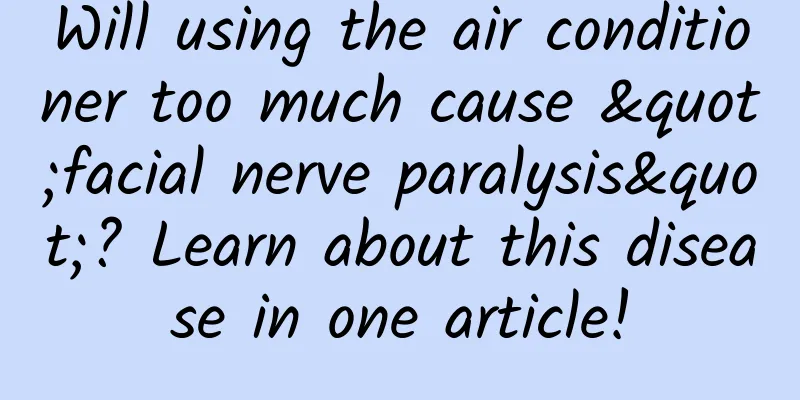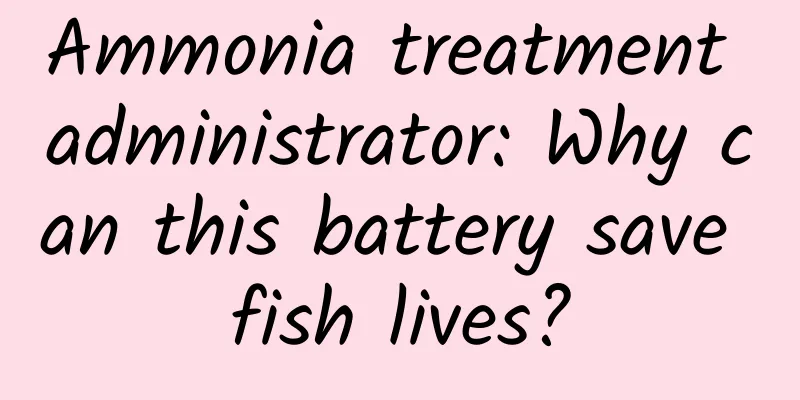Will using the air conditioner too much cause "facial nerve paralysis"? Learn about this disease in one article!

|
In the hot summer, if you try to cool down after sweating profusely or use air conditioning improperly, the body surface temperature will change suddenly, which will stimulate the facial nerves and may cause neural tube functional disorders, resulting in symptoms such as facial stiffness, numbness, drooling, and facial paralysis. This is facial nerve paralysis, the so-called "facial paralysis." Image source: Chinese Medical Association What is facial nerve palsy? Facial nerve paralysis is also known as "facial neuritis" or "Bell's palsy", commonly known as "facial paralysis", "crooked mouth" and "hanging line wind". It is a motor dysfunction of the facial expression muscles caused by damage to the facial nerve. The main manifestations are crooked corners of the mouth on the affected side, difficulty closing the eyes, puffy cheeks and air leakage, incomplete index teeth and drooling. It is a common and frequently occurring disease that is not limited by age. How is facial nerve paralysis treated? Early treatment is mainly based on medication to improve local blood circulation and eliminate inflammation and edema of the facial nerve. Late treatment is mainly based on facial muscle function training to promote muscle fiber contraction and blood circulation, control facial muscle spasm and prevent facial muscle atrophy, and promote functional recovery. 1 Drug treatment (1) Oral corticosteroids: oral prednisone acetate or dexamethasone. (2) Neurotrophic metabolic drugs: vitamin B1, vitamin B12, methylcobalamin, citicoline, etc. (3) Oral antiviral drugs: Oral acyclovir or valacyclovir can be selected. (4) Chinese patent medicine: Some Chinese patent medicines that promote blood circulation and remove blood stasis can be used to promote the recovery of facial nerve. 2 Physical therapy (1) Ultrashort wave non-thermal treatment is given near the styloid foramen for 10 minutes once a day to improve nerve ischemia and edema. (2) After the acute phase, local infrared irradiation can be used to accelerate local blood circulation, promote the elimination of edema, and relieve pain. (3) During the recovery period, low- to medium-frequency stimulation can be used locally to help improve active contraction of facial muscles. 3 Exercise therapy (1) Eyebrow lifting exercise: Try your best to lift the eyebrow on the affected side upwards. (2) Nose-lifting exercise: lift your nose upward. (3) Teeth showing training: Use force to show teeth and move the corners of the mouth to the side. (4) Lip pursing exercise: Contract your lips forcefully and pucker your lips forward. (5) Cheek puffing exercise: Ask the patient to close his lips as tightly as possible so that both cheeks are inflated with air. (6) Eye closure training: Use force to close the palpebral fissure. Image source: Chinese Medical Association Practice each of the above movements 10 to 20 times, 2 to 3 times a day, to promote the recovery of facial expression muscles. How to care for facial nerve paralysis? 1 Protect your eyes People with incomplete eye closure are prone to photophobia and tearing. They need to protect their eyes in time and avoid rubbing their eyes with their hands. Wear sunglasses in strong light during the day, put eye drops twice a day in the morning and evening, or cover with eye ointment before going to bed. Reduce contact with electronic screens to avoid conjunctivitis. 2 Diet care Avoid eating spicy, greasy, cold foods, as well as "irritating foods" such as seafood, beef, mutton, leeks, peanuts, etc., and eat more vegetables, fruits and whole grains. Copyright images in the gallery. Reprinting and using them may lead to copyright disputes. 3 Facial Treatment Apply a hot and wet towel to the affected side of the face at a temperature of 50℃ to 60℃, 2 to 3 times a day, 10 to 15 minutes each time. Massage the affected side yourself in the morning and evening, using gentle, moderate, and continuous force, and massaging the correct area. 4 Oral Care When eating and chewing, food is easily retained between the teeth and cheeks on the affected side, so care should be taken to ensure oral hygiene. You can rinse your mouth with warm water after meals and brush your teeth before going to bed. 5 Other considerations Pay attention to keeping your face warm and avoid direct wind; pay attention to rest, avoid staying up late, do not sleep on a cool mat, and keep the mobile phone away from your head; increase exercise (change into dry clothes in time after exercise) to increase resistance. Planning and production Produced by: Chinese Medical Association Author: Huang Liurong, The Second Affiliated Hospital of Hainan Medical College Review丨Chen Bocan, deputy chief nurse of the Second Affiliated Hospital of Hainan Medical College Editor: Yinuo The cover image and the images in this article are from the copyright library Reprinting may lead to copyright disputes |
<<: Cold dishes are also "dangerous goods". How should we eat cold dishes healthily in summer?
>>: What is the difference between a 5-cent egg and a 5-dollar egg? The answer is...
Recommend
2021 Jiebao linkage system course "Leopard Brother Short-term Practical System Course" and "Jiebao Trading System Advanced Edition" video + handouts
2021 Jiebao linkage system course "Leopard B...
Apple Watch sapphire screen test: too brutal
The biggest regret of iPhone 6 is not the lack of...
Most of Hungary's electric vehicle investment comes from China, and its growth rate far exceeds that of Germany and France, making it the first small power in Europe
On the topic of electric vehicles, the whole of E...
Sony PlayStation launches several heavyweight Chinese games. The game version of "The Return of the Great Sage" aims to reshape the Chinese mythology system
Due to various well-known reasons, the era of con...
Operators must read: 19 ways to promote APP for free
It is easy to develop an app, but difficult to ge...
Explosive title: A super simple trick to quickly increase the title opening rate!
When users quickly browse through massive amounts...
I have a dry mouth and drinking water doesn’t quench my thirst. Why?
Review expert: Guo Xiaoyan, deputy chief physicia...
Xianyu Product Analysis Report: Is it reliable to use a trading platform to play a social card?
This product analysis report is mainly aimed at u...
An internationally recognized type of carcinogenic food, many families eat it for three meals a day!
Singer Fu Song died of oral cancer at a young age...
Google confesses to providing employee data to the FBI
On December 23, 2014, Christmas Eve, Google infor...
Where is the way out for nine out of ten online variety shows that are star-studded?
As soon as the summer comes, major TV stations an...
Smali disassembly language data types and methods
Introduction to Smali Smali is a disassembly lang...
How to operate a (product) APP?
This article is a summary of novice operations . ...
The entire process of building and optimizing information flow advertising accounts
Too little exposure and no sales? How to set a re...
Zhihu account anti-ban rules and product promotion guidelines!
1. My experience of selling products on Zhihu, fr...









